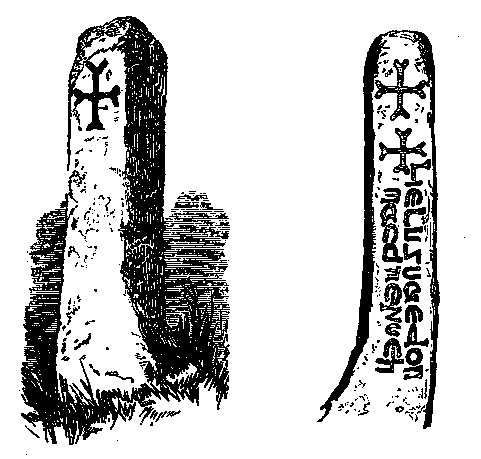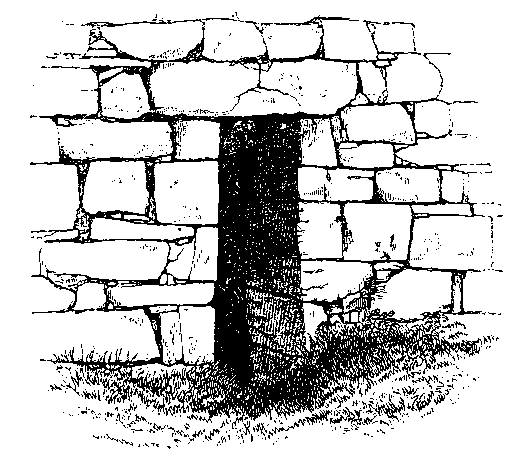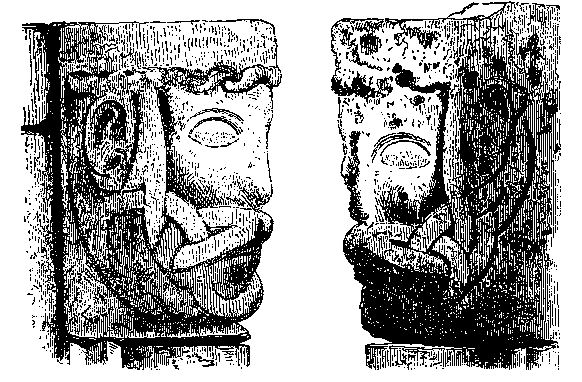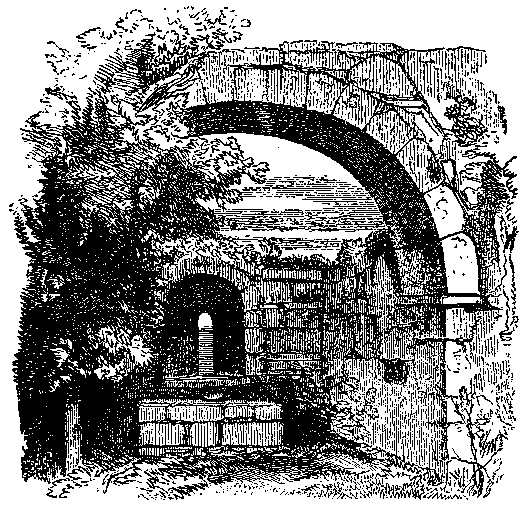Chapter 6: Inis Uí Chuinn to Inis A' Ghaill and Cunga Fheichín (Cong)
- Islands of Loch Coirib
- Shrule
- Ballycurrin House
- Inchagoill
- Inís mhic a'trír
- Cross Castle
- Ancient Churches of Cill Fraocháin
- Moytura
- [?? no title yet]
Return to table of contents
Refer to Map
In the south-east of this parish, and to the right of road between Máighin and Cros, there are several objects worthy of inspection, especially the great Pagan forts of Cathair Mór and Cathair an Uilc (Cahernahilk).
We are still in Mayo waters: in the barony of Kilmaine, and legally within
the limits of the extensive and celebrated parish of Cong, which forms the
entire northern boundardy of Loch Coirib in both counties, and extends from
its junction with that of Shrule to near the bridge of
Mám, a distance of
about
Inchagoill--Inis an Ghaill Chraibhthigh, "the island the devout foreigner,"--which now rises its long graveyard, in an ridgelike back to the west of our course, is by far the most interesting island on the lake.
On an undulating slope, where the island narrows towards its centre, an extensive graveyard, in an ancient ecclesiastical enclosure, marks where, so long as there were any of the name left in the country, the Kinnaveys, Conways, Sullivans, Murphys, Lyddans, Butlers, and others, interred their dead; and many a wild wail of Irish keen has floated over the surrounding waters, as the funeral procession of boats, with their picturesquely clad freights, approached the shore of this sacred isle.
Within the graveyard, lately enclosed by its present proprietor, Sir
Benjamin Lee Guinness, Bart., the restorer of St. Patrick's, stand the ruins
of two exceedingly ancient churches,
both of the small Irish type,
but of far different styles
and dates. That to the north-east, which is much older and
plainer, bears all the characteristics of its period in its narrow
square-headed doorway, with inclined jambs, and Cyclopean style of its
masonry. It was not built due east and west, but inclines to the north of
the former, and south of the later, and sometimes occurs in our very
early Irish churches. This little Teampull Phádraig,or "St.
Patrick's church," which is
What gives the most special interest to this locality is the
preservation there of a monumental stone, containing, undoubtedly, one
of the very earliest Christian inscriptions in Ireland. It is a single
four-sided obelistical pillar, of hard, greyish Silurian stone,
unhewn, slightly cambered, broad at the base, where it measures ten
inches, and gradually decreasing from six to five inches on the
inscribed side, which faces the south-west end of St. Patrick's
Church, and from which it is distant a few paces. This monolith now
stands two feet four inches over the ground, as a headstone to a
grave, but that such was not its originail position is manifest; and
it has all the appearance of
 having been one of those corbel stones so often seen projecting in old
Irish churches, and of which there is an example in the north-east
angle of the gable of the neighbouring "Church of the Saints." It has
at top two crosses on the west, two on the east (as shown in the
accompanying illustrations), two on the south, and one on the north
face, which may be regarded as examples of the most ancient carvings
of that sacred emblem now to be found in the British Isles, or
perhaps, if we except those in the Catacombs of Rome, anywhere in
Europe.
having been one of those corbel stones so often seen projecting in old
Irish churches, and of which there is an example in the north-east
angle of the gable of the neighbouring "Church of the Saints." It has
at top two crosses on the west, two on the east (as shown in the
accompanying illustrations), two on the south, and one on the north
face, which may be regarded as examples of the most ancient carvings
of that sacred emblem now to be found in the British Isles, or
perhaps, if we except those in the Catacombs of Rome, anywhere in
Europe.
On the first face is an inscription, in the Uncial or old Latin character, here reproduced from a most careful rubbing lately taken by the Earl of Dunraven. [3cp137-1] It reads perpendicularly, and was first published in 1845 by the late Dr. Petrie, in his celebrated work upon "The Ecclesiastical Architecture and Round Towers of Ireland," as Lie Lugnaedon Macc Limenueh "the Stone of Lugnaedon, son of Limenueh," the sister of St. Patrick. Taking the authorities in consecutive order it may be observed that Roderick O'Flaherty, who first informed us of the ancient name of this island, makes no allusion to this monolith. In 1810 an officer quartered in Galway described it in a local newspaper, and an Irish-speakulg soldier of his regiment gave a fanciful interpretation of its inscription. [3cp137-2]
In 1839 our great topographer, John O Donovan then employed upon the Ordnance Survey, visted the island, along with Mr. Wakeman, who made most careful drawings of the stone,and all the other object of antiquarian interest in connexion with these two churches; and O Donovan's illustrated communication of the 27th of June in that year is preserved in that great repertory of Irish history, see The Ordnance Letters of the Antiquities of the County of Galway, vol. iii, page 46 now in the Library of the Royal Irish Academy.
With reference to this stone he writes thus at page 50: It "exhibits a very ancient inscription, in the Roman characters, of the fifth or very beginning of the sixth century"; and adds, "That this Lugnaedon Macc Limenueh was no other than Praesbyter Lugnath, who was the son of Liemania, otherwise Darerca, the sister of St. Patrick, is highly probable, though we have no account of his having lived or being buried in this island.According to the `Book of Lecan,' fol. 5I, p. 5, col. b Presbyter Lugna (otherwise called Lugnath), was the alumnus of St. Patrick, and son of his sister; and he was located at a place called Fearta, in Tír Féig, on Loch Mask, where Duí Teanga Umha, King of Connacht, gave him and his fellow-labourers the lands extending from that part of Loch Mask called Snámh Tíre Féig to Sail Dea.In the same MS., fol. 45, a I, he is called St. Patrick's Luamaire or navigator.The Irish authorities are not, however, all agreed upon the history of this saint, some making him the son of St. Patrick's sister Lupita, some of his sister Darerca, and others of Liemania ! But this stone is a co-temporaneous monument, and should be received as historical evidence to prove that he was the son of Liemania.This inscription is the oldest Christian monument I have yet seen; and, whatever doubts there may be about the history of this saint, as given in the Irish MSS., there can be none about the authenticity of this inscription."
A short distance to the south-east is the second building --Teampull na Naomh, "the church of the Saints," and an ancient flagged way, seventy-nine yards long, leads between the two. It is a more modern and highly decorated structure than that called after our great Irish missionary, and lies nearly due east and west. It measures thirty-eight feet one inch from out to out, of which twenty-six feet four inches is the length of the wall of the nave, and eleven feet nine inches that of the recessed chancel, which is five feet eleven inches wide at the eastern end. The masonry of this church is, to a certain extent, laid in courses, except a portion of the south wall, which is very massive, or what is called Cyclopean; but the quoins and several other stones were dressed. Projecting from the north-east angle of the wall of the nave is a remarkable corbel-shaped stone, two feet for inches long, that reminds one strongly of the Lugnaedon pillar, and strengthens the opinion given at p61.
Here are shown the doorways of the Inis a' Ghaill churches. The first
represents the plain, severe, square-headed doorway of the primitive church,
or Teampull Phádraig. And on the oposite side we have
represented the beautiful, highly decorated, circular-arched, cluster
pillared doorway of Teampull na Naomh, and between the

 erection of which and the former, some centuries must have
elapsed. This marvellous doorway, which is a grand specimen of early
Irish decorative art, is decidedly anterior to the date of the
Anglo-Norman conquest.
Like its elder brother adjoining, it is placed on the western gable, and its
jambs slope slightly inwards.[fn65-1] Its dimensions are five feet eleven
inches from the lower edge of the arch to the sill, two feet two
inches wide at bottom,
and two feet at top--almost the same as that of its primitive
neighbour, previously described. The entire thickness of this doorway
is thirty-nine inches; it is formed of a reddish drab coloured
sandstone, such as that found on the Cong side of the lake, where, as
here, it has become porous or pitted with small depressions.
erection of which and the former, some centuries must have
elapsed. This marvellous doorway, which is a grand specimen of early
Irish decorative art, is decidedly anterior to the date of the
Anglo-Norman conquest.
Like its elder brother adjoining, it is placed on the western gable, and its
jambs slope slightly inwards.[fn65-1] Its dimensions are five feet eleven
inches from the lower edge of the arch to the sill, two feet two
inches wide at bottom,
and two feet at top--almost the same as that of its primitive
neighbour, previously described. The entire thickness of this doorway
is thirty-nine inches; it is formed of a reddish drab coloured
sandstone, such as that found on the Cong side of the lake, where, as
here, it has become porous or pitted with small depressions.

The jambs are formed by columnar pilasters, which are crowned by human-face capitals, from which springs the arch, the middle portion of which is carved into deep, horizontally projecting chevrons, over which is a row of faces, each differing from the other, and which may, for aught we know, have been portraits; but all are now so much defaced by weathering on the surface, and by the pitting already alluded to, as to efface their individuality.
The impost capitals are of exceeding interest, as they show a form
of beard plaiting and knotted hair work
rarely represented in sculpture.
These, on the north and south sides, are most faithfully represented in
the annexed cut. A similar form of decoration is to be seen on the fillet
underneath the cap of the Round Tower of Devenish

on Loch Erne, which is probably of contemporaneous antiquity.The
entire space included by the pillars and mouldings of this entrance is
four feet ten inches. Upon entering the church, the view here figured,
presents us with the low undecorated chancel-arch, altar, and deeply
splayed round-headed eastern light. This arch measures eight feet
seven inches in span; and from the keystone to the flagging beneath is
nine feet seven inches.
The nave is twenty-one feet seven inches by twelve feet nine inches
in the clear; and in the south wall there is a small, narrow,
round-headed light, six feet from the ground, and deeply splayed
inside. In the western corner of that wall may be seen one of the most
remarkable

pieces of carving on the island. It consists of a flat,
irregularly-shaped, reddish stone, two feet two inches high, and three
feet ten inches wide, built into the masonry in this Cyclopean wall,
of which it evidently formed an original part. Indented upon its
surface is the very ancient Greek or Byzantine cross here figured, the
base or skeleton of which is of the same type as that on the stone of
St. Brecán, at the Seven Churches in Aran Mór, and on many ancient
Irish tombstones. It is said that a similar cross exists at
Ard-Oileán, or "High-Island," opposite the coast of Conamara.
The stone altar of this church is still perfect, and measures four feet seven inches, by three feet four inches wide, and one foot ten inches high. Upon it are two remarkable indented stones: one has an oblong quadrilateral hollow, six and a half inches long, by four wide; the other, placed immediately under the small, eastern, round-headed single light, is a smooth stone, with an oval-shaped depression, six by four inches in diameter, capable of holding the closed fist--probably a very early font. It belongs to that class of cupped stones called in Aran, where they abound, Bulláns, and of which there are many at Gleann Dá Loch in Wicklow, of which "the deer stone" may be cited as an example.--See page 82.
On a stone of the ancient flagged way leading up to the western end of this church, is carved a square cross, with fish-tail terminations, like those on Lugnaedon's stone, and which is, no doubt, of great antiquity also.
Outside the north-east angle is a piece of square masonry, ten and a half feet by seven feet eight inches, and about four feet high, believed to be the tomb of Muirgheas Ó Nioc, Archbishop of Tuaim, who died here in 1128.
O'Flaherty, in whose footsteps we have been treading, wrote thus of this island in 1684: "Inis a' Ghaill, so called of a certain holy person who there lived of old, known only by the name of An Gall Cráibhtheach, i.e. the devout foreigner; for Gall (i.e. of the Gallick nation), they call every foreigner. So Inis an Ghaill, or the foreigner's island, between Ross and Moycullen barony on Loch Oirbsen, contains half a quarter of pleasant land belonging to Cong Abbey, and hath a fine chappell therein, which is not for the buriall of any body." And further adds, that it "hath two chapells, the one dedicated to St. Patrick, the other to the saint of whom the island is named, which admits not the buriall of any body, but in the first it is usuall to bury."